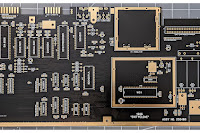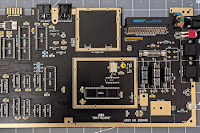Good light, so I'm told, can often be had during bad weather and the night before I had resolved to resist the urge for a few more hours in bed and instead get up, get out, and see if there was a colourful sunrise that might make getting up at stupid O'Clock in the morning, worthwhile.
I was out of the house at 6.30am. As I walked towards the beach there was already a very promising glow in the sky. Sunrise was at 7.36am. It was only a 20 minute walk and my pace quickened as I felt the stirring of excitement in my belly. Perhaps this wasn't such a bad way to spend a morning?
The tide was almost fully in when I arrived at me pre-chosen spot. Not ideal but still accessible. There was still plenty of room for me to explore but clambering about on rocks, in the dark was a heart quickening experience. A broken ankle would not be ideal. However I could see sufficiently well that I didn't yet need the torch and I soon found a nice stable spot to set up my tripod.
That's when the rain started. It was almost exactly 7.00am. The wind, while by no means gale force, was certainly strong, but not blowing so hard it would shake the tripod too hard. However, it added some momentum to the gentle drops now falling from a very dark sky. Out to sea however the sky was really starting to warm up nicely and there was a great deal of promise in the orange and purple colours.
Out of my rucksack came the camera. First things first I needed to know what my exposure was going to be. Now bear in mind my camera is not weather sealed. My chosen lens isn't weather sealed either and whilst I'm not overly precious and I'm happy enough to let a few drops hit it, I'm not so relaxed that I can let it get drenched. The wind and rain was sufficiently gentle that I was happy enough to let it sit on the tripod while I messed about with the settings. A test shot at ISO100, f/4 and a 3 second exposure gave me some nice colours but it was far too dark for autofocus to work so I would have to focus manually. That would be fine. I still had about 25 minutes before sunrise and as it got lighter I would be able to close down the aperture (f/8 would be ideal) and the shutter speed would be whatever it needed to be at the time. I looked at the switches on the side of the lens to change it to manual focus and I couldn't remember which switch was for manual focus and which switch was for image stabilisation. No problem, that's why I have a torch. So, I dug the torch from the top compartment of my rucksack and switched the lens to manual focus.
Right about then the rain started to get a whole lot heavier. There was now no way I could now leave the camera on the tripod so off it came and I stuffed it back in the main compartment of the rucksack. However, while doing this I forgot that I had unzipped the top compartment to get the torch out and so, whilst the camera was now safe and dry, everything which had been in the top compartment fell out onto the beach. My external battery pack and lens wipes were now rolling about amongst the rocks. What a damn moron. I set about picking them up and now my fingers were covered in sand, and if there's one thing that will kill a camera besides water, it's sand. God dammit.
I was then in the position where the light was starting to look nice but the rain was starting to soak through my jacket. The good news was that all the water was running down my sleeves and over my hands, washing the sand away but, there was now no way I could use the camera without a rain cover. I do in fact carry one of these for precisely this sort of occasion.
My rucksack is not one dedicated for cameras. It's a standard 25 litre rucksack that can just about fit my camera; a small second lens; some snacks and a few other bits and pieces in the main compartment. Those bits and pieces were at the bottom of the rucksack, under the camera. And one of those bits and pieces was the rain cover.
It started to dawn on me right then that this wasn't going to work. To get the rain cover I was going to need both hands, so I wouldn't be able to hold the camera as I rummaged, and I couldn't leave the camera on the tripod or the rocks either - it was far too wet. And in the process of digging the rain cover out I would then get everything else in the rucksack soaked, like that second lens, which I didn't even need and should never have brought.
I stood in the the wind and rain, feeling the water starting to run down my legs inside my trousers (which were shower-proof - definitely not waterproof) and watched the sky for another 5 minutes or so contemplating my situation. This definitely was not worth risking the camera for. I felt more than a little bit stupid at how badly I had organised my gear.
So at 7.15am I gave up. I packed up the tripod, slung the rucksack over my shoulders, and started the wet trudge home. As I left the beach I took one last look back and saw that all the lovely light was slowly being snuffed out by thick, grey clouds on the horizon and it was still 15 minutes before sunrise. I would never have got the picture I had wanted anyway.
Now whilst all of this was somewhat humiliating and disappointing, like the title of this article says, this whole saga was an object lesson in preparedness:
- I was stupid not to have the camera rain cover easily accessible when I knew the weather could turn - I had made a point of looking at the weather forecast!
- I was stupid bringing all those extra bits and pieces that I was never going to need and which overly complicated my predicament.
- I was stupid forgetting which switch on my lens does what. I should really know that stuff by now.
These are mistakes I'll not make again. I'll take these lessons to heart and, with luck, my next dawn adventure will be a bit more productive, and a whole lot less stupid. In the meantime, I just need to console myself with this ghastly, pixelated, blurry mess I was able to grab with my mobile phone; a poor vision of what might have been:




